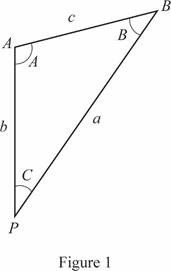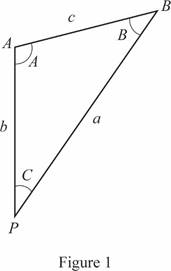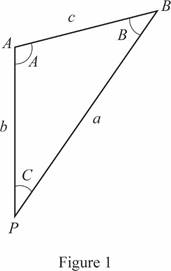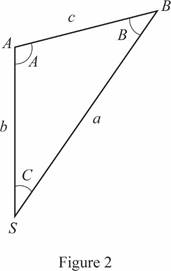
Concept explainers
(a)
The distance between the cow A and cow B.
(a)
Answer to Problem 73AP
The distance between the cow A and cow B is
Explanation of Solution
The figure 1 below shows the location of the cow A, cow B and the person.

Use the law of cosine to write the formula for the sides a, b, and c.
The distance between the cows is the side
It is given that,
Conclusion:
Substitute
The distance between the cow A and cow B is
(b)
The angle between the person and cow B as seen by the cow A.
(b)
Answer to Problem 73AP
The angle between the person and cow B as seen by the cow A is
Explanation of Solution
The figure 1 below shows the location of the cow A, cow B and the person.

Use the law of cosine to write the formula for the sides a, b, and c.
The angle between the person and cow B as seen by cow A is the angle
Re-write the above equation to get an expression for
It is given that,
Conclusion:
Substitute
The angle between the person and cow B as seen by the cow A is
(c)
The angle between the person and cow A as seen by the cow B.
(c)
Answer to Problem 73AP
The angle between the person and cow A as seen by the cow B is
Explanation of Solution
The figure 1 below shows the location of the cow A, cow B and the person.

Use the law of cosine to write the formula for the sides a, b, and c.
The angle between the person and cow A as seen by cow B is the angle
Re-write the above equation to get an expression for
It is given that,
Conclusion:
Substitute
The angle between the person and cow A as seen by the cow B is
(d)
The angle between star B and sun as observed by an inhabitant of a planet orbiting star A.
(d)
Answer to Problem 73AP
The angle between star B and sun as observed by an inhabitant of a planet orbiting star A is
Explanation of Solution
The figure 2 below shows the location of the star A, star B and the sun S.

Use the law of cosine to write the formula for the sides a, b, and c.
The angle between the person and cow A as seen by cow B is the angle
Re-write the above equation to get an expression for
It is given that,
Conclusion:
Substitute
The angle between star B and sun as observed by an inhabitant of a planet orbiting star A is
Want to see more full solutions like this?
Chapter 1 Solutions
Physics for Scientists and Engineers with Modern Physics, Technology Update
- air is pushed steadily though a forced air pipe at a steady speed of 4.0 m/s. the pipe measures 56 cm by 22 cm. how fast will air move though a narrower portion of the pipe that is also rectangular and measures 32 cm by 22 cmarrow_forwardNo chatgpt pls will upvotearrow_forward13.87 ... Interplanetary Navigation. The most efficient way to send a spacecraft from the earth to another planet is by using a Hohmann transfer orbit (Fig. P13.87). If the orbits of the departure and destination planets are circular, the Hohmann transfer orbit is an elliptical orbit whose perihelion and aphelion are tangent to the orbits of the two planets. The rockets are fired briefly at the depar- ture planet to put the spacecraft into the transfer orbit; the spacecraft then coasts until it reaches the destination planet. The rockets are then fired again to put the spacecraft into the same orbit about the sun as the destination planet. (a) For a flight from earth to Mars, in what direction must the rockets be fired at the earth and at Mars: in the direction of motion, or opposite the direction of motion? What about for a flight from Mars to the earth? (b) How long does a one- way trip from the the earth to Mars take, between the firings of the rockets? (c) To reach Mars from the…arrow_forward
- No chatgpt pls will upvotearrow_forwarda cubic foot of argon at 20 degrees celsius is isentropically compressed from 1 atm to 425 KPa. What is the new temperature and density?arrow_forwardCalculate the variance of the calculated accelerations. The free fall height was 1753 mm. The measured release and catch times were: 222.22 800.00 61.11 641.67 0.00 588.89 11.11 588.89 8.33 588.89 11.11 588.89 5.56 586.11 2.78 583.33 Give in the answer window the calculated repeated experiment variance in m/s2.arrow_forward
 Principles of Physics: A Calculus-Based TextPhysicsISBN:9781133104261Author:Raymond A. Serway, John W. JewettPublisher:Cengage Learning
Principles of Physics: A Calculus-Based TextPhysicsISBN:9781133104261Author:Raymond A. Serway, John W. JewettPublisher:Cengage Learning Physics for Scientists and EngineersPhysicsISBN:9781337553278Author:Raymond A. Serway, John W. JewettPublisher:Cengage Learning
Physics for Scientists and EngineersPhysicsISBN:9781337553278Author:Raymond A. Serway, John W. JewettPublisher:Cengage Learning Physics for Scientists and Engineers with Modern ...PhysicsISBN:9781337553292Author:Raymond A. Serway, John W. JewettPublisher:Cengage Learning
Physics for Scientists and Engineers with Modern ...PhysicsISBN:9781337553292Author:Raymond A. Serway, John W. JewettPublisher:Cengage Learning College PhysicsPhysicsISBN:9781305952300Author:Raymond A. Serway, Chris VuillePublisher:Cengage Learning
College PhysicsPhysicsISBN:9781305952300Author:Raymond A. Serway, Chris VuillePublisher:Cengage Learning College PhysicsPhysicsISBN:9781285737027Author:Raymond A. Serway, Chris VuillePublisher:Cengage Learning
College PhysicsPhysicsISBN:9781285737027Author:Raymond A. Serway, Chris VuillePublisher:Cengage Learning An Introduction to Physical SciencePhysicsISBN:9781305079137Author:James Shipman, Jerry D. Wilson, Charles A. Higgins, Omar TorresPublisher:Cengage Learning
An Introduction to Physical SciencePhysicsISBN:9781305079137Author:James Shipman, Jerry D. Wilson, Charles A. Higgins, Omar TorresPublisher:Cengage Learning





